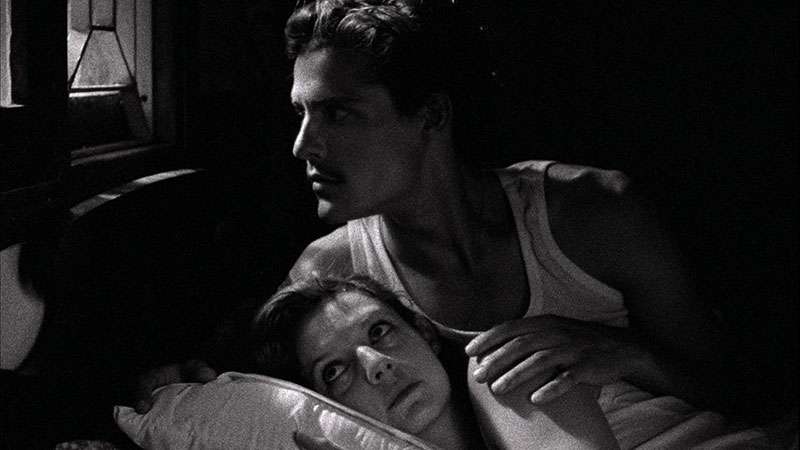[This review in slightly different form appeared in the Festival Coverage section in September.]
Miguel Gomes: TABU
CARLOTO COTTA AND ANA MOREIRA IN TABU
Shooting back in time to an exotic forbidden love
The title the director Migues Gomes has given his third feature, Tabu, alludes to a fictitious mountain in an undesignated Portuguese African colony in the 1960's. It's also an allusion to F.W. Murnau's 1931 movie, Tabu: A Story of the South Seas . The second half of the new film, shot in 16mm. black and white film and converted to 35mm. in old fashioned square format (as is the lackluster first half) tells a story of doomed but passionate adulterous love between a dashing, mustachioed musician, Gian Luca Ventura (Carloto Cotta) and Aurora (Ana Moreira), the young wife of an equally young but less exotic tea plantation owner (Ivo Müller). The story like a Somerset Maugham short story without the punch line, or Hemingway one without the moral complexity. It's a bit shallow; but it's nonetheless beautiful, stylish, and inventive. Gomes' first half, centered on the adulterous lady as a tiresome senior citizen in Lisbon (Laura Soveral) who loses everything at a casino and then dies in hospital, is heavily scripted and featuring several drab, uninteresting older women. It's only when the former love, Ventura (Henrique Espírito Santo), still distinguished looking, appears after the funeral and begins telling the story that the good stuff begins. You could certainly argue that the first part is necessary to set up the long voiceover and semi-silent dumbshow of the adultery tale, but it doesn't need to be so long. One brief description in the Village Voice by Nick Pinnkerton calls this "a broke-back, diptych film," noticing that Murnau's Tabu is similarly split. As Pinkerton's word, "broke-back," suggests, there's something uneven and disabled about this film's construction.
When the filmmakers got to Mozambique they threw away the strict playbook they used for the first part and instead improvised their story's details from day to day. They got the cast to pretend to talk, but as we watch their many activities, including music by a depressing pool and a brief scene of surprisingly sexy lovemaking (given the period formality of much of the rest), we only hear the voiceover, and ambient sounds of nature, suggesting the place is still alive but the people are long gone; also alluding to silent film, though the date of the events is during the time of rock and roll, and the musician-lover is drummer in a band that plays and sings in English in an American rock-pop style. Gomes really does achieve a sense of time-travel with this mood and format.
While Gomes' film is flawed, it is evocative and very cinematic; even the name Aurora is a reference to Murnau's 1931 film, though in a Q&A after the NYFF press screening, the Portuguese director made clear that his memories and allusions to earlier films are vague and impressionistic -- and that the film isn't meant to be a comment on the Portuguese colonies that were freed in 1974 but rather a comment on movies (and stories?) about adulterous love affairs in this kind of setting. Ventura becomes guilty about the forbidden relationship and tries to end it. But many decades later the two lovers still pined for each other; Aurura's husband had died young but she had never remarried.
The music has an excellent period flavor. Gomes' dp Rui Pocas shot the Lisbon contemporary scenes in 35mm, the flashback ones in 16mm, contrasting a crisp look with a blurrier more vivid one. With his tan, sinewy slimness, and little mustache Carloto Cotta, as the young lover, has a deliciously seedy-sexy quality and the Variety reviewer Jay Weissberg, who saw the film at Berlin, is right to mention also that "he has the suave, captivating elegance of a young Errol Flynn." Cotta gives the doomed romance sequences their signature look. A part of the visual theme too is the cunningly old-fashioned way the starkly mountainous landscapes are shot, and the motival use of a small crocodile that Aurora's husband gives her as an eccentric present, but later disappears and winds up at Ventura's place -- twice.
Flawed, slim, Tabu is nonetheless memorable and beautiful.
After festival showings (it was screened for this review at the New York Film Festival), it's being released in he US by the new label Adopt films (Jeff Lipsky), which also released Christian Petzold's Barbara (now showing at Angelika Film Center in NYC). In the NY Times A.O. Scott has published a shrewd and informative new review on the day of the film's Film Forum release.
Tabu, 118mins., in Portuguese, in black and white, opens at Film Forum in Lower Manhattan December 26, 2012.This could be a story by Isak Dinesen or Ernest Hemingway, in which rich Europeans act out their desires against a backdrop of imperial privilege.
. . .If the film enacts a fall, it is from a relatively guiltless present into a more corrupt past that is also a realm of greater beauty and more intense feeling.
This is a dubious notion, and “Tabu” makes it convincing only within the narrow compass of its own artifice. It is, of course, art rather than history — an elegant composition of dreams, memories and suggestive images — but its artfulness seems like an alibi, an excuse for keeping the ugliness of history out of the picture.
--A.O. Scott.





 Reply With Quote
Reply With Quote
Bookmarks